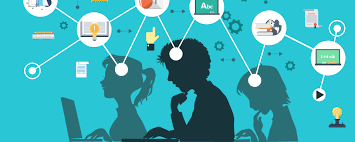What is the importance of digital literacy to students?

Digital literacy should not be confused with computer know-how. The former refers to understanding the issues, benefits, and side-effects that come with the digital world. This type of education combines critical thinking, social interaction, and familiarity using many digital tools.
The COVID-19 pandemic caused many changes. One such shift was in the education and work system. Everything went online. Digitalization was once an option but now it is the only choice. This has made digital tools indispensable for both teachers and students.
Digital literacy is a vital life skill, according to UNESCO’s Information for All Program. Digital literacy means that a person can use digital technologies to create and learn. So, let’s understand why Gurgaon Top Schools are considering Digital literacy in their education system:
Importance OF Digital Literacy To students
The student-teacher interaction that technology brings to the classroom is one of the greatest benefits. You can make lessons more interactive by using audio, video, and/or transcripts. Students can get real-time feedback. This will allow them to understand not only the content of the explanations but also the tone and emotion behind the words written on paper or online.
It can also make teaching more inclusive. It has been a long-standing question about how educators can use technology to empower students to speak up. Our customers have seen how technology can be used to create safe learning environments that allow students to express themselves freely and teachers to connect with their learners more personally.
The long-term benefits of teaching digital literacy outweigh any drawbacks. Digital literacy enables students to be more socially aware and responsible. It also allows them to engage in critical thinking when they are faced with the online world. Schools are responsible for ensuring that today’s children are well-equipped for the future.
Why digital literacy is important?
Many students have access, either at school or personal, to some type of device that allows them to search the web. It could be a tablet or phone, or a computer. Teachers and parents need to help students interact and navigate the digital world with ease, given the increasing use of digital resources within the curriculum.
Digital literacy skills allow students to move beyond a process-oriented knowledge of technology and use digital resources creatively in original work. These skills are based upon the traditional notions of literacy and allow students to use their critical thinking skills.
These skills are not only useful in the classroom but also for post-secondary opportunities that require basic knowledge of technology. Teachers can encourage students to be digital citizens and responsibly use technology to prepare them for success after graduation.
Digital Literacy for the Classroom
Digital literacy in the classroom is the ability of students to recognize quality sources and understand authorship rules. It also helps them to evaluate the credibility of online content that is relevant to their assignment or task. How to:
- Find relevant videos and images
- Learn how word choice can convey bias
- Participate in online communities
- Fact-check research
- Evaluate online resources
- Cite Sources and Other Copyrighted Material
- Differentiate real news from fake news
Students learn digital literacy by incorporating it into the classroom. Digital learning platforms and the internet help students to evaluate their behavior, engagement, and interactions.
Digital Literacy Empowers Students
Students have greater access to online education than ever before. Teachers are best able to guide students in making safe digital choices and using digital resources effectively. Technology is rapidly changing the world, as well as K-12 education. Digital literacy can help students stay on top of technology in the classroom and beyond.
Adapting to the digital environment
Lack of devices access is one of the most significant and obvious barriers schools face. Although school funding may not always permit students to own a device, this shouldn’t stop schools from striving to make it a reality. Digital literacy is essential for students’ future success. Every institution should have a plan and a timeline for this goal.
Going digital also means considering cybersecurity, privacy, and data protection. Schools should prepare students for the future. This includes recognizing cyber threats, creating a sense that one is responsible for their digital presence, or helping to create healthy relationships between the real world and devices.
Teachers’ digital literacy is the final barrier. It can seem overwhelming for many teachers as they need to learn how to use technology in lessons before they bring it into the classroom. The best CBSE School India can implement a digital literacy program that encourages staff retention, teacher forums and allows teachers to share knowledge about technology.. Teachers can also be involved in the decision-making process for which software to use.
Conclusion
Technology is a growing force in all areas of human life, including the daily lives of students. Students need to be more open to learning in the digital age. This is where digital literacy can help and we know the Digital world is Now becoming the Future. So, when it comes to choosing the best schools in Gurgaon, consider the one having digital literacy



